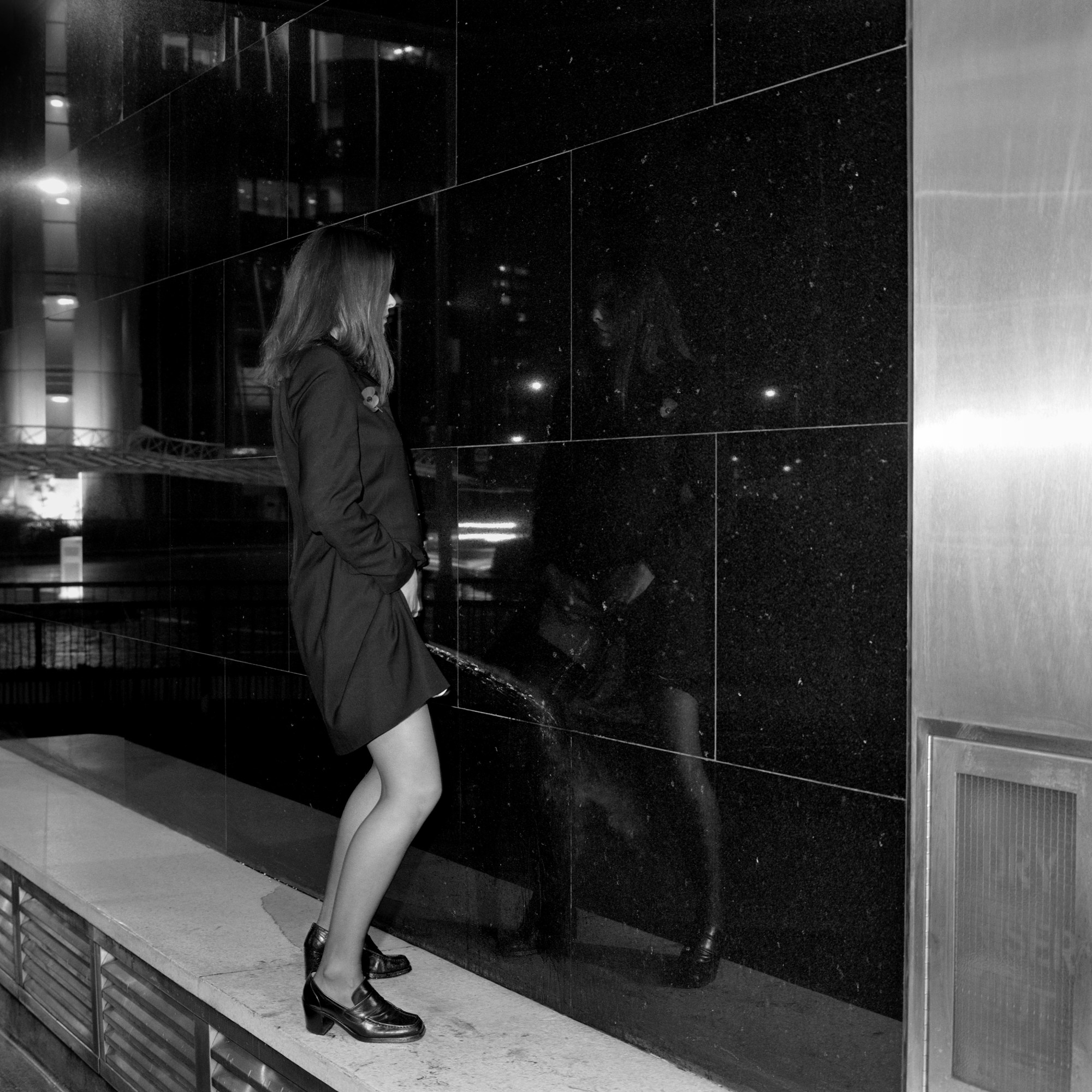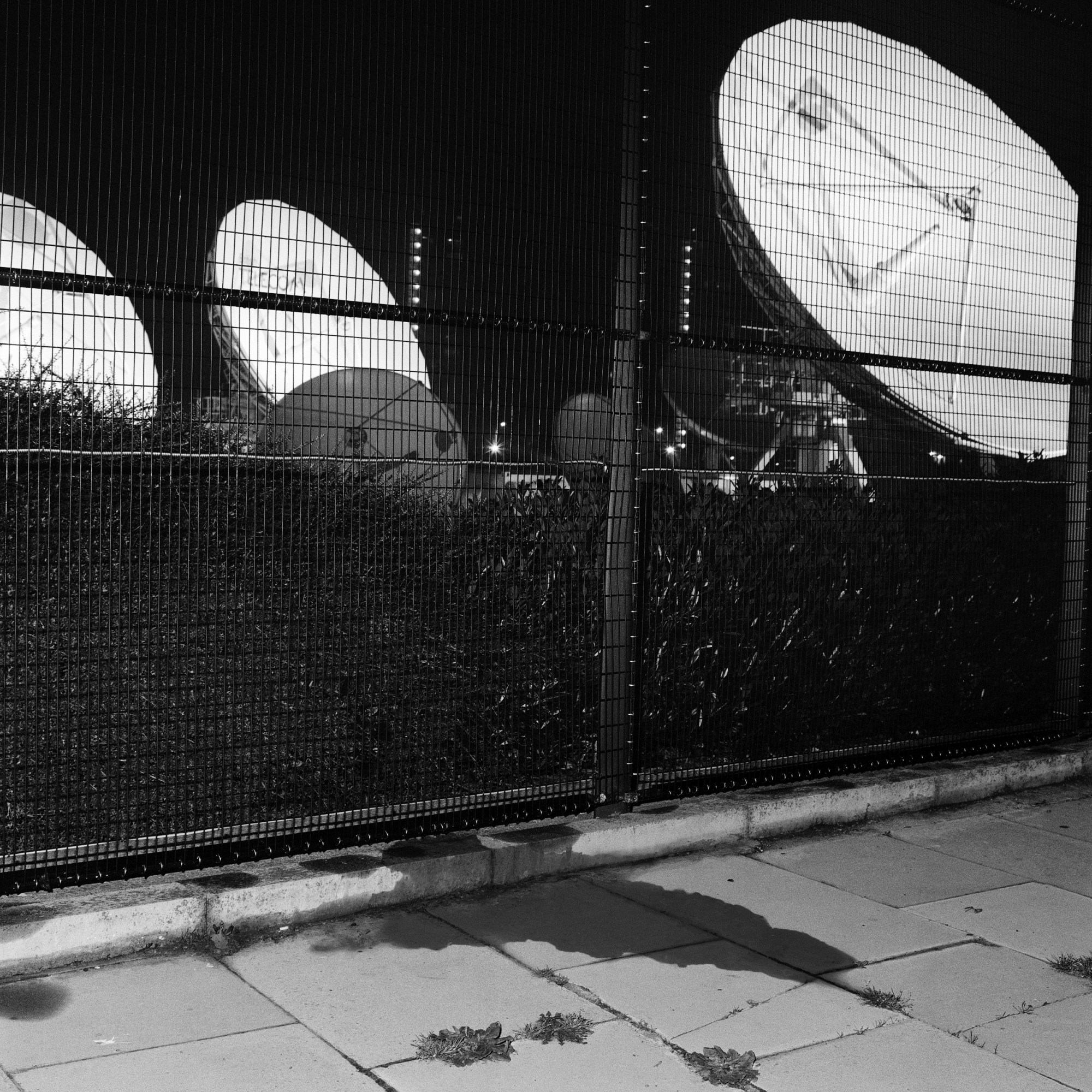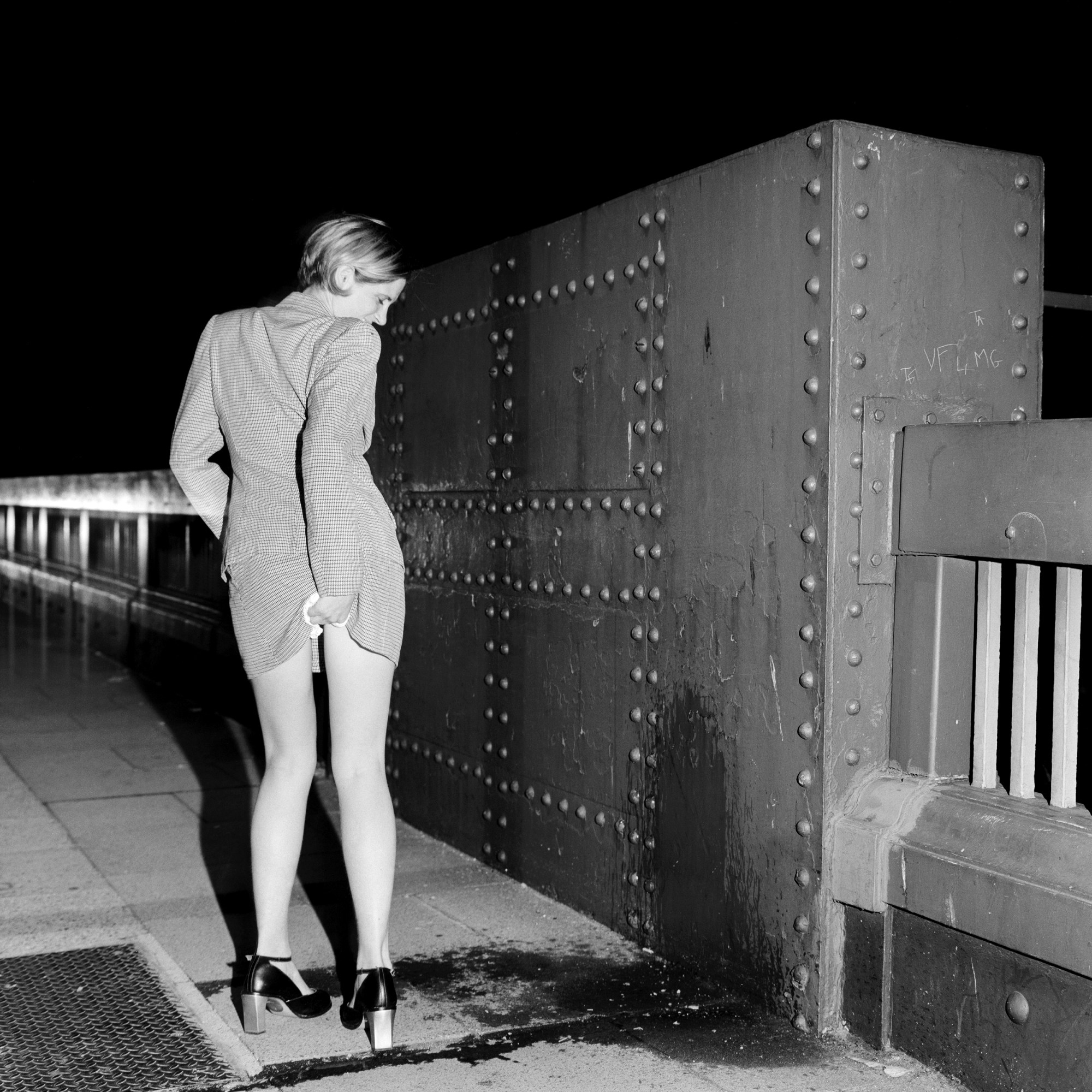At Glastonbury Festival in 1994, the artist Sophy Rickett, then 23, found herself struck yet again by the disparity in how men and women piss. Men, brazen and unbothered, spattering it up walls in public; women, mandatorily discreet, always confined to privacy. It’s part of the wider canon of things that we as women should never let the world know we do: piss, shit, bleed, wank, age. So, what does it mean to show a female body performing such functions? And what does it mean to view it?
Later that year, Sophy began photographing herself and her friends pissing on the streets of London at night. Dressed up in “office wear,” they descended on locations representing patriarchal capitalism – the financial district, the MI6 building in Vauxhall, the corporate office blocks of Old Street – to performatively stage this phallic act. The resulting images, a brilliantly deadpan parody of machismo, went on to become Sophy’s seminal 1995 series, Pissing Women. Now, almost 30 years later, it’s published in its entirety for the first time by Climax Books.

With all that’s changed in the art world since 1995 – and a lot that hasn’t in the confines and performance of gender – it’s an interesting moment for the project to resurface. “Today, you might assume that [the piss streams] are Photoshop since that’s so ubiquitous now,” Sophy tells me over the phone. “Back then, the assumption was that we had some sort of funnel or were squirting from a bottle.” Across decades, a tendency to assume artificiality has persisted — but there is none, she insists. (Surely the piss just dribbles down your legs, I muse, impressed by the projection of her streams. “No, it doesn’t. Try it in the shower.”)
The longer you look at the images in Pissing Women, the funnier they become. The ill-fitting suit jackets (“People thought mine was Vivienne Westwood, but my housemate Becky [Earley, the designer and professor at University of the Arts London] bought it in a charity shop”); the perfectly masculine slouch in the womens’ stances; the hint of a grin on the artist’s face. Sophy was temping as a secretary at the Financial Times at the time, and the after-hours risk-taking signalled her disillusionment with the banality of it all. “It represents a certain moment in early adulthood which feels quite universal,” says Isabella Burley – former Dazed editor-in-chief, founder of Climax, and editor of the book – over email. “A time in your early 20s where you are fearless. You have this desire to push and question the world around you, to experiment, react, rebel.”

On several levels, Pissing Women was made at a definitive moment in British history. Not just personally for Sophy as a young woman but for society as a whole. 15 years of Tory rule was coming to an end. A new century was approaching. Sophy sat among a fresh generation of female image-makers turning their everyday experiences into social commentary. And with the early internet about to blow up, a whole new media landscape was dawning: one of unchecked chaos and breakneck speed, one where, as Isabella says, “ownership and authorship were suddenly in freefall.” “Of course, at the time, you’re not aware of it,” Sophy says. “You don’t realise the extent to which everything is about to change. In the early 90s, the internet felt so niche — we’d laugh about it, like, ‘What even is a backslash?’ We had no idea.”
In particular, Sophy was oblivious to how her images, exhilaratingly perverse as they were, would be quickly co-opted by fetish websites. What started as something “funny and political and jokey” began to spark sinister responses (her recollection of a male stranger at her first institutional exhibition – who, under the guise of seeking portfolio feedback, sprung a collection of hardcore porn on her – feels like a precursor to today’s unsolicited dick pic epidemic).

In this way, Pissing Women isn’t just an example of how technologically unregulated the early internet was, but how unregulated people were in what and how they were documenting. “We were making these things for an analogue age, unaware that we were entering a digital one. One where, once something’s out there, you lose control of it; you have no control over how it’s used and interpreted and consumed and reproduced.” It echoes the fall-out of the internet’s “first viral sex tape” – that of Pamela Anderson and Tommy Lee – which was stolen from their home in the same year Pissing Women was released.
“I didn’t know that piss porn was a thing,” Sophy swears, reflecting on the results she found after searching her own name back then. Really? I ask. “God, no. I was only 24.” The rationalisation feels both comical and poignant at a time when one in 10 children have watched pornography by the time they are nine. Today, oceans of explicit imagery are but a click (or tap) away. “And it’s all about consumption,” Sophy points out. “Emphasis is on the consumption of the material rather than the performance of something.” Pissing Women was never intended that way. “[The emphasis was] on the performance, and the performer, rather than the transactional nature of viewing what the performer’s doing and how it’s being perceived and understood.” It seems even when we take pains to subvert it, women are reduced to a sight for consumption. As the art critic John Berger once said, “Men act and women appear.”

Pissing Women went on to be exhibited and auctioned around the world. And for all the seediness that came from it, one of the principal things the series represents is the joy and reward of young female friendships, a mix of “mucking about” and meaningfully influencing one another’s work. Alongside Becky Earley thrifting the outfits, the shoes were lent by their friend Nicky Lawler, who went on to co-found 90s shoe brand Lawler Duffy and is now Head of Footwear at Vivienne Westwood. And Sophy’s unruly experimentation with the artist Rut Blees Luxemburg – whose series of the same era, Chance Encounters, had the pair photographing one another chatting up male city workers at night – was integral to the evolution of Pissing Women. In stark contrast to the lone masculine auteur, “I couldn’t have done any of it without them. We were constantly working together, cross-referencing, inspiring each other and being inspired. And that’s still ongoing.”
Sophy’s practice has evolved into something quite different in the decades since the photos were taken. But, her interest in disrupting patriarchal and institutional structures persists. As Pissing Women is given new life in 2023, it still feels shocking. It still feels relevant. And it’s still fucking funny. In the end, it’s a reminder of how the same cultural conversations – about gender, ownership, performance and consumption – rematerialise in different packaging across generations. Same piss. Different toilet. (Or a different wall to spatter it up.)

Credits
All images courtesy Sophy Rickett and Rut Blees Luxemburg
